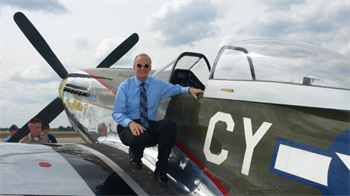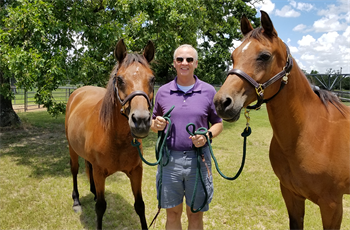AIAA Member Spotlight – June 2018 Written 15 June 2018
AIAA Profiles AIAA Fellow Dr. John Valasek
By Michele McDonald, AIAA Communications Manager

John Valasek was destined to become an aerospace engineer all thanks to the simple fact that his mother attended a Blue Angels airshow in Los Alamitos, California, when she was seven months pregnant with him in 1961.
And Valasek is not one to argue with this family lore.
“We have video of my family taken at that airshow, and my parents never hesitated to attribute my strong interest in aerospace to my attending (so to speak) that airshow,” he said. “From the moment I was born I showed an interest in aircraft and I have not looked back. There was never consideration of any other career.”
A prolific author, his work has benefited private industry, academia, and perhaps most of all, students. An AIAA Fellow and active volunteer, Valasek is the founding director of the Center for Autonomous Vehicles and Sensor Systems (CANVASS), headquartered at Texas A&M University in College Station, Texas. The aerospace engineering professor also is the director of the Vehicle Systems & Control Laboratory at Texas A&M.
When he returned to school for his graduate degree, his original plan was not to become a professor but to become a better aerospace engineer when he returned to his engineering job at Northrop Corporation.
“Over time I realized that helping others is very fulfilling,” Valasek said. “As a result, my graduate school goal changed from simply becoming a better engineer to getting better at helping others to succeed, and I re-vectored my career path to academia.”
The results have been gratifying, he added.

“My favorite events are when any of the students I mentor and advise—both undergraduate and graduate—achieve their goals. Two highlights that stand out in particular are when two of my graduate students were named the outstanding researcher for all of Texas A&M University: Anshu Narang-Siddarth at the Ph.D. level in 2013, and Joshua Harris at the M.S. level in 2018.”
Valasek earned the B.S. degree in Aerospace Engineering from California State Polytechnic University, Pomona in 1986, and the M.S. degree with honors and the Ph.D. in Aerospace Engineering from the University of Kansas, in 1990 and 1995, respectively.
Valasek joined AIAA as a student member in 1983. He learned about AIAA from students in his department. The Cal Poly Pomona student branch was large and active during those years, with a membership of about 80 percent of the students, he said. He volunteered to be an officer and became chair his senior year.
“They made it easy to see that being a member of the professional society of your major was important not only during school, but during the professional phase of the career,” he explained.
Student conferences were formative events in his academic career, Valasek said. He attended the Region VI Student Paper Conference in 1984 (Stanford), was the student chairman of the event in 1985 (Cal Poly), competed in the conference in 1986 (San Diego State), and competed in the graduate division in Region V in 1990.
“I believe that all students can benefit from them and continue to encourage and mentor students to participate in both student paper conferences and professional AIAA conferences,” he said.
Valasek has five things he recommends to today’s and tomorrow’s students. Frankly, this advice is good for anyone.

“First and foremost, eschew ALL trappings of entitlement,” Valasek stressed. “It will not enhance your career, it will limit it.
“Second, don’t wait for opportunities to come to you, but rather seek them out and then act on them immediately. Good things come to those who find opportunities and then act on them.
“Third, be a leader. Teamwork is important, but strong good leadership is what the very best people in our profession have, and everyone benefits from it. Even if you are not naturally a leader, you can develop it too.
“Fourth, learn to be comfortable being uncomfortable. Embrace lifelong learning and always improve yourself by learning new things that are outside of your comfort zone. That is how you will grow and thrive as both a person and a technical professional.
“Fifth, don’t pursue your passion in life; be passionate about pursuing your purpose in life. It is up to you to determine what your unique purpose in life really is. All five of these recommendations are easy to implement once your mind is set on them.”
Valasek’s work in the private sector inspired him to improve his knowledge in his areas of expertise, leading to an academic career and benefiting his students. He served as a flight control engineer for Northrop Corp.’s Aircraft Division where he worked in the Flight Controls Research Group, and then in the Flight Controls Analysis Group on the AGM-137 Tri-Services Standoff Attack Missile (TSSAM) program.
“Both groups were great to work in,” he said. “What I enjoyed most was the privilege of working with and learning from an elite and very talented group of engineers, several of whom graduated at the top of their class. Many had at least one graduate degree. The work was very demanding in terms of required effort and time, particularly for a recent graduate, and these engineers motivated me to learn fast and keep up with them. This in turn inspired me to pursue a graduate education for the sole purpose of improving my technical abilities, to become the best engineer I could possibly be.

“Now as an academic, I use my experiences from industry to bring my classroom lectures alive, providing real-world motivation for the topics being discussed.”
He directly credits AIAA for his first professional job as a new graduate.
“A student officer who graduated the year before I did, contacted me during my senior year about a job opening in his group at Northrop Corporation. That was the beginning of my career in aerospace engineering, and I am grateful to him for it.
“The best part of the networking that AIAA provides to its members is the opportunity to be introduced to people and then to help them to advance their careers, whether it be through job recommendations, research collaborations, tenure and promotion references, or nominating and supporting them for awards. Helping aerospace grow and thrive through its members is what AIAA is all about.”
Valasek has been an active AIAA member for decades. He’s served in numerous volunteer roles throughout the years, including as a former member and Chair of the AIAA Atmospheric Flight Mechanics Technical Committee, AIAA Guidance, Navigation, and Control Technical Committee, and the AIAA General Aviation Technical Committee, as well as a nominator for the Pendray Aerospace Literature Award. His current roles include Associate Editor of the Journal of Guidance, Control, and Dynamics, member of the Unmanned Systems Integration and Outreach Committee, and member of the Intelligent Systems Technical Committee.
He does have his favorites.
“The technical committees are my favorite way to serve AIAA and the profession. You have the opportunity to make a difference in many different ways, and you get to meet and work with great people who become friends for life.
“What I am most proud of in my technical committee service to AIAA are the two awards that I created for the Atmospheric Flight Mechanics Conference: Best Student Paper and Most Influential Paper. The latter award reviews papers from 25 years ago at the conference and evaluates which one has turned out to be the most influential over time.
Volunteering to serve on a journal is a very important service to the profession since the journals have the responsibility of not only archiving and disseminating noteworthy technical advances, but also of setting the standards for excellence and enforcing them, he said.

“One of my mentors, Ping Lu, encouraged me to apply for an Associate Editor position on the Journal of Guidance, Control, and Dynamics, and I am glad he did. It is very rewarding to be assigned a manuscript that clearly makes a contribution but is not yet in the shape yet to be understood and appreciated by the technical community, and then to help the author refine and publish it. When that manuscript is the first journal paper to be accepted and published for any author, it is all the more rewarding since you are helping that person achieve a major milestone in their career.”
Valasek has received numerous industry awards and several AIAA awards throughout his career, as a member of the AIAA Fellows Class of 2017, AIAA Associate Fellows Class of 2002, as recipient of the 2014 ASEE/AIAA J. Leland Atwood Award as a national outstanding aerospace educator, and as a recipient of the national Faculty Advisor Award from AIAA in 2005, to name a few.
“To me the spirit of John Leland Atwood is about making a difference in students’ lives,” he said. “I feel very blessed to receive this recognition because two professors of mine who made a difference and helped shape my academic career, Conrad F. Newberry and Jan Roskam, are themselves recipients. I also have five colleagues here at Texas A&M University who are previous recipients, and they continue to mentor and inspire me to this day. I hope to continue to do the same for my students past, present, and future.
When he’s not in the classroom or volunteering for AIAA, Valasek keeps busy.
“In our spare time, my wife Stephanie and I enjoy caring for and riding our purebred Arabian horses Ziggy and Mystery,” he said. “We also enjoy running long distance road races, especially when we can combine our vacations with these races. We have run three full marathons in addition to many races between the distances of half-marathon to marathon. The London Marathon and the Yellowstone National Park Marathon are on our bucket list.
“I have enjoyed building plastic scale models—primarily aircraft—since the age of 5, and I am an avid board wargamer of 40+ years. In my quiet time I like to read non-fiction history, with my favorite period being the age of U.S. imperialism (1890–1945).”
AIAA salutes Dr. Valasek for his lifetime of contributions to our industry and wishes him all the best as he continues his vital mentoring of the next generation of aerospace engineers.
